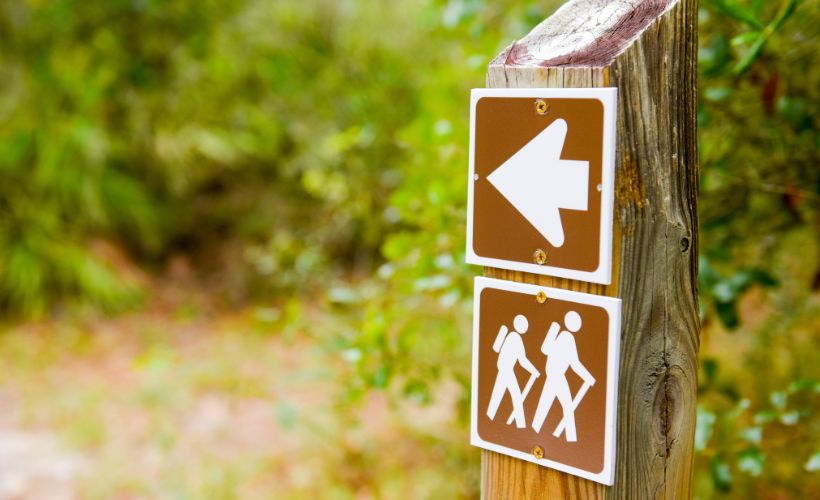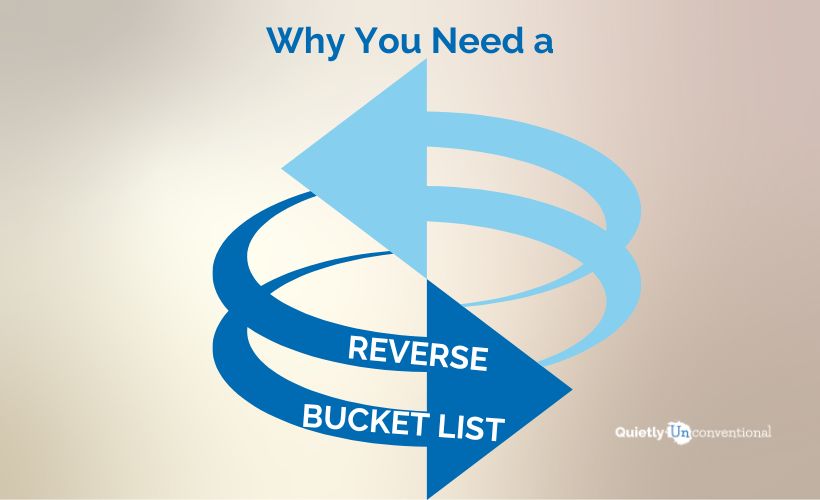A well-thought-out bucket list is a valuable guide for future planning. It helps you invest time and money into activities that matter to you. But sometimes knowing what you don’t want to do is just as helpful. That’s where a reverse bucket list comes in.
Reverse bucket list vs anti bucket list
There are two ways to look at a bucket list in reverse. The first is what I’ll call an anti bucket list—a list of things you don’t ever want to do or experience.
Trials and unpleasant surprises are a part of life. We get sick, lose loved ones, and endure tasks that are no fun. We don’t enjoy these sorts of things, but we can’t control them. Making a list of things we can’t control isn’t helpful.
Neither is a list of things we refuse to try. Sure, it’s good to know your non-negotiables (I will not commit a crime, I will not root for the Cowboys) but compiling a list of things we think we won’t enjoy is likely to stifle us. How do we know for sure if we refuse to try?
This reminds me of the approach my son takes with his toddlers. They must try a new food at least once before they decide they don’t like it. We should adopt a similar attitude when considering new experiences and activities.
That’s where the reverse bucket list comes in. It’s a list of things or experiences I’ve intentionally tried at least once but have decided that I don’t want to experience again. In other words, now that I’ve tried it, I get to say “No thank you.”
What’s the point in making a reverse bucket list?
Trying and eliminating things can help you clarify what you want. This is the premise behind job shadowing, for example. Sometimes experiencing a “day in the life” of a particular career helps a person decide the career is not for them.
Likewise, there is benefit in considering things we thought were a good idea, but now we know better. I’m talking about things we’ve done on purpose or experiences that were a consequence of an intentional decision we made.
Such a list could help us remember lessons learned from mistakes, highlight where our priorities have changed, or help us develop principles that we can apply to similar circumstances.
I’ll give you some examples from my reverse bucket list to illustrate what I mean.
Clarifying principles gleaned from life lessons
After my dad died, Mom tried to handle the estate on her own. I eventually took over. Since she wasn’t using a lawyer, I didn’t either. But I felt very out of my depth, and it gave me a lot of anxiety. I DID NOT want to face that anxiety again! Thus, when Mom passed away two years later, I hired a lawyer. It was SO much better! I felt much less stress, the process went much smoother, and I have confidence that everything was done correctly.
“I will never again handle an estate without a lawyer” is definitely on my reverse bucket list. Why?
Because I learned a life lesson. It’s worth it to pay experts to do certain things. It’s an investment in your peace of mind. It gets done a lot quicker without you wasting hours trying to figure it out. And it’s done correctly the first time.
So, I might add this principle to my list as well: “I want to avoid trying to do things on the cheap instead of paying for valuable expertise and adding unnecessary stress to my life.”

Leaning from mistakes and making better future decisions
A wise person always tries to learn from their mistakes. A reverse bucket list is a place to apply those lessons so next time we’ll make better decisions.
For example, my list will include “I won’t hike in Utah during the hottest months.”
Utah has amazing scenery, but the last time we vacationed there, it was way too hot to enjoy long hikes. I’d love to go back and visit Utah’s stunning scenery, but next time I’ll choose a cooler month. Lesson learned.
Here’s another example.
Several years ago, we were camping in the White Mountains of New Hampshire. We decided to spend one day hiking to the top of Mt. Liberty. We saw that it was part of the Appalachian trail and figured that if people with backpacks could hike it, so could we.
The hike was a lot tougher than we’d expected. Miles of steep, rocky path heading pretty much straight up.
The mistake? We didn’t do our homework ahead of time. We made assumptions about how difficult the hike was, and we made assumptions about how fit we were. We’re not thirty-somethings anymore. Our goal is to enjoy a hike and a view, not to prove how tough we are.
We’re proud we made it to the top, but we don’t need to tackle a hike this strenuous again.
Defining changing priorities
As we move from one season to another, our priorities change. A reverse bucket list can reflect this by including things that used to be important, but no longer are.
My example: “I quit trying to find a good gluten-free donut.”
Donuts have always been a favorite in our family, especially the ones from our favorite local bakeries. Unfortunately, since I’m now gluten-free, I can’t eat them anymore.
I tried for years to find a gluten-free donut that satisfied. I’ve been disappointed time after time, so I’ve decided it isn’t worth the calories to keep trying. Rather than stubbornly hoping the next time will be different, I’ve learned to focus on other gluten-free baked goods that are delicious.
What would you put on your reverse bucket list?
What’s something you’ve done that you don’t want to do again? Something you originally thought would be fun or rewarding, but looking at it from the perspective of today, you don’t want to repeat.
How can adding this experience to your reverse bucket list help you make better future decisions?
P.S. I’d love to hear your answers. Post them in the comments below.


1. In college, my Kansas farmgirl roommate invited me to her home one weekend. The farm had a tall silo with a metal ladder attached. Vicki asked me if I wanted to climb to the top of the silo. I almost made it before I became paralyzed with fear. There was no way down unless I moved myself and slowly came down. It was a horrifying experience. I will never climb to the top of a silo. (1970)
2..At an adventure family camp with my children, we went to a large rock wall outside of Lake City, Colorado and we hiked to the top of the mountain, to repel down the rock wall. Again, I froze in fear… and it took two counselors from the camp to come down repelling with me sobbing all the way. I could not stop shaking and crying even when I was on the ground safe. I will never repel again. (1994)
3. As a result of the above two experiences, I will never climb a rope or flimsy ladder that goes high again. On a sailing trip on a old tall ship, moving fast through the Adriatic Sea, the guests were climbing the rope ladder high up to the crows nest. I am afraid of heights, and I knew I would get paralyzed with fear. As my companions kept pushing me to climb telling me I could do it, I too knew I could do it….I didn’t want too. And I didn’t. I made my decision based on the reverse bucket list above. (2013)
It’s wise to know our limits and not make the same mistake again. No matter how much others assure us it will be fine.